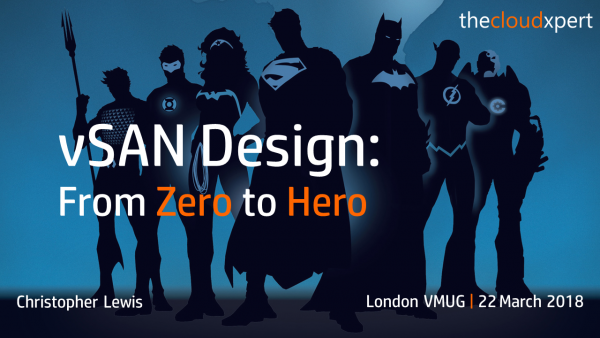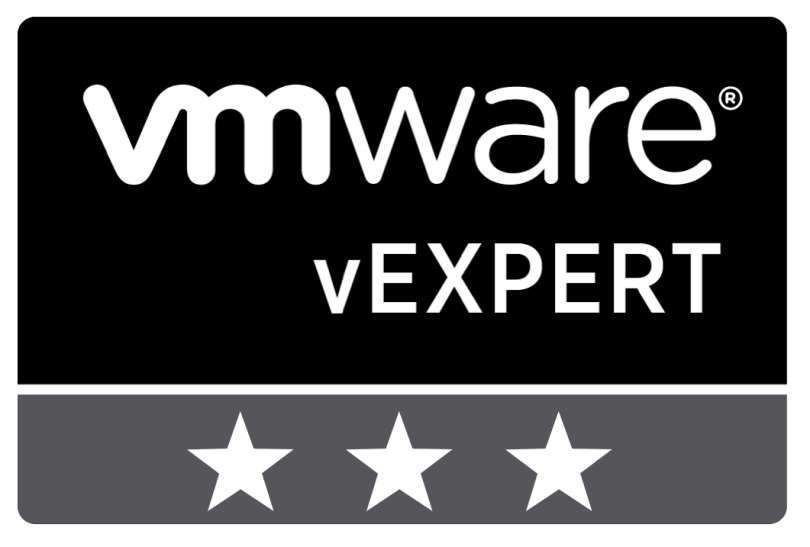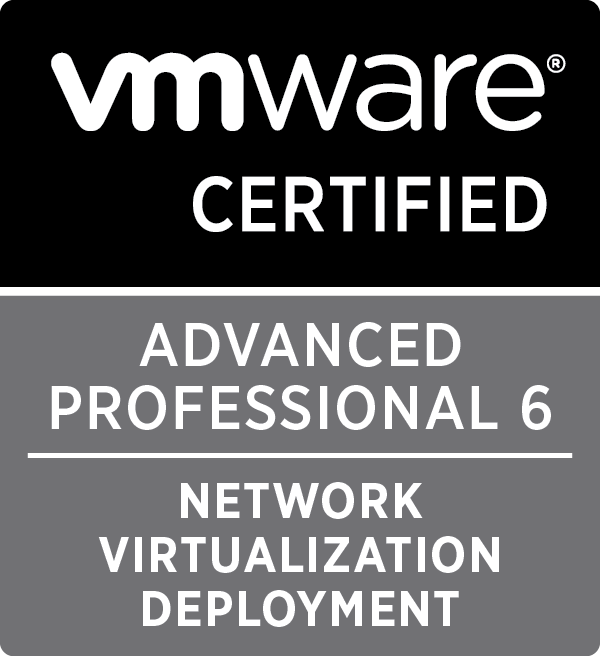London VMUG - March 2018 - vSAN Design: Zero to Hero

Last week I had the pleasure to present to the guys at the London VMUG for the first time. On vSAN no less!
Written by Christopher Lewis on March 26, 2018 .
VMware
VMware vSAN
VSAN
Written by Christopher Lewis on March 26, 2018 .
Achievement Unlocked: VMware vExpert 2018

Humbled to be chosen for VMware vExpert 2018!
Written by Christopher Lewis on March 9, 2018 .
vExpert
vExpertCloud
vExpertNSX
VMware
Written by Christopher Lewis on March 9, 2018 .
VMware Cloud Briefing March 2018 - The Highlights

Today was a big day for VMware and VMware Cloud Services with their global Cloud Briefing. Read my thoughts on what was said!
Written by Christopher Lewis on March 8, 2018 .
AWS
Cloud
Cost Insight
Log Intelligence
VMConAWS
VMware
VMware Cloud Services
VMware vSAN
VSAN
Wavefront
Written by Christopher Lewis on March 8, 2018 .
2017 - A Year in Reflection (Better Late than Never)

I realise I am a little late to the party with 2017 reflection posts, but I am going to do one anyway.
Written by Christopher Lewis on January 22, 2018 .
VMware
Written by Christopher Lewis on January 22, 2018 .
Updating the embedded vRealize Orchestrator 7.3 Certificate
This is a
series
of posts covering the replacement of vRealize Automation SSL Certificates. This post cover replacing the vRealize Orchestrator Certificate.
Written by Christopher Lewis on December 12, 2017 .
Certificates
VMware
vRealize Automation
vRealize Orchestrator
Written by Christopher Lewis on December 12, 2017 .
Replacing the vRealize Automation 7.3 IaaS Manager Service Certificate

This a
series
of posts covering the replacement of vRealize Automation SSL Certificates. This post cover replacing the vRealize Automation IaaS Manager Service Certificate.
Written by Christopher Lewis on December 11, 2017 .
Certificates
VMware
vRealize Automation
vRealize Orchestrator
Written by Christopher Lewis on December 11, 2017 .
Replacing the vRealize Automation 7.3 IaaS Web Certificate

This is a
series
of posts covering the replacement of vRealize Automation SSL Certificates. This post cover replacing the vRealize Automation IaaS Web Service Certificate.
Written by Christopher Lewis on December 11, 2017 .
Certificates
VMware
vRealize Automation
vRealize Orchestrator
Written by Christopher Lewis on December 11, 2017 .
Replacing the vRealize Automation 7.3 Appliance Certificate

This is a
series
of posts covering the replacement of vRealize Automation SSL Certificates. This post cover replacing the vRealize Automation Appliance Certificate.
Written by Christopher Lewis on December 11, 2017 .
Certificates
VMware
vRealize Automation
vRealize Orchestrator
Written by Christopher Lewis on December 11, 2017 .
Replacing SSL Certificates in vRealize Automation 7.3

In this series of posts we will walk through the process of upgrading all of the vRealize Automation Certificates. We will be moving from self-signed certificates that were deployed during the installation, to certificates that have been provided by an Enterprise Certificate Authority (CA).
Written by Christopher Lewis on December 11, 2017 .
Certificates
VMware
vRealize Automation
vRealize Orchestrator
Written by Christopher Lewis on December 11, 2017 .
Recent Posts:
- Introducing the Super Metrics Repository
- Creating Super Metrics for Counting Ascendent/Descendent Object Metrics in a List View
- Creating a Custom Resource Action - Part 1: Getting Started & API Discovery
- Operating a Private Cloud - Part 3: Creating a Pricing Card in VMware Aria Automation
- Operating a Private Cloud - Part 2: Creating a Pricing Card in VMware Aria Operations
Blog Categories:
active directory 6
aria automation 9
aria automation orchestrator 1
aria operations 2
aws 2
blog 1
career 1
certificate authority 5
certificates 5
certification 91
cloud management 1
cloudnativecon 1
community 1
fun 1
general 9
hands on labs 1
home lab 2
kubecon 1
kubernetes 1
microsoft 7
nsx 45
nsx v 41
powercli 8
powershell 6
reviews 1
vcap 48
vcap6 2
vcenter 4
vcix 2
vexpert 9
vmug 5
vmware 99+
vmware aria 1
vmware aria automation 9
vmware aria automation orchestrator 1
vmware aria operations 5
vmware cloud 3
vmware cloud director 1
vmware explore 2
vmware identity manager 2
vmworld 36
vrealize automation 80
vrealize automation saltstack config 1
vrealize business 2
vrealize log insight 1
vrealize operations 1
vrealize operations manager 5
vrealize orchestrator 13
vrealize suite 14
vrealize suite lifecycle manager 20
vsan 5
vsphere 9
windows 6
Top Tags:
active directory 6
api 18
barcelona 24
certificates 11
certification 7
howto 33
microsoft 7
multi tenancy 9
nsx v 43
platform services controller 8
powercli 8
powershell 7
psc 6
vcap 9
vcap6 45
vcap6 cma 48
vcap6 nv 37
vcix6 nv 36
vexpert 19
vmug 8
vmware 99+
vmware aria 12
vmware aria automation 9
vmworld 35
vmworld 2016 13
vmworld 2017 9
vra 13
vrealize automation 74
vrealize operations 8
vrealize orchestrator 21
vrealize suite lifecycle manager 11
vrslcm 20
vsan 7
vsphere 12

